巨型熊猫和道教圣殿; 巨型的冰和雪雕; 成都 & 哈尔滨, 中国

中国, 成都, 成都大熊猫繁育研究基地
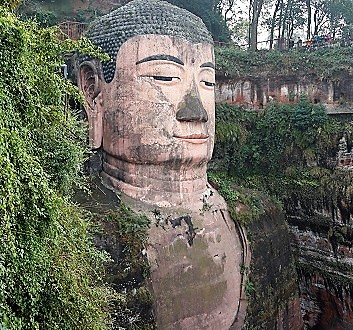
中国, 成都, 乐山大佛
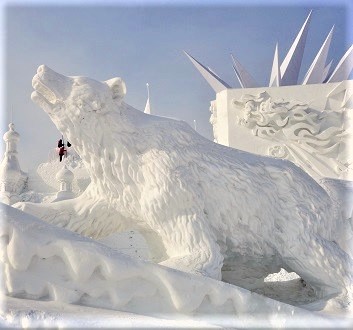
中国, 哈尔滨, 哈尔滨国际冰雪雕塑节
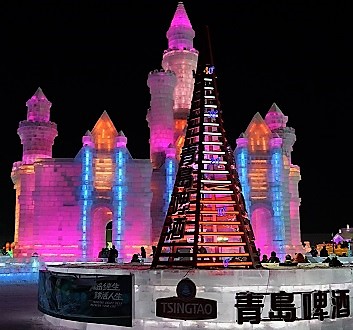
中国, 哈尔滨, 哈尔滨国际冰雪雕塑节
旅游计划
天 1 - 到达成都, 中国
Our Chengdu & Harbin, China Itinerary follows a week-long journey to Tibet (Tibet, China Itinerary). We take a direct flight (2 hour flight) from Tibet (Lhasa), China to Chengdu, China. Upon arrival at the Chengdu Shuangliu International Airport, we use private transfer services organized through our hotel (approximately 45 minutes’ drive). We arrive in the early evening and enjoy dinner in our hotel. Note: Our Chengdu & Harbin, China Itinerary takes place in the winter so we can visit the famous Ice and Snow Festival in Harbin.
Note: Our Chengdu & Harbin, China Itinerary may be used separately or combined with our Tibet, China Itinerary. Option 1: Take a direct flight to Chengdu, China from China’s main international hubs of Beijing and Shanghai and follow our 7-Day Chengdu & Harbin, China Itinerary. Option 2: Following a week-long journey in Tibet (Tibet, China Itinerary), take a direct flight (2 hour flight) from Tibet (Lhasa), China to Chengdu, China.
天 2 - 成都大熊猫繁育研究基地, 成都文殊佛教寺院,成都香料市场
Our day excursion start with a half an hour drive north of Chengdu to the Chengdu Research Base of Giant Panda Breeding, an expansive territory that recreates the natural habits of the giant pandas. During our multi-hour visit, we observe giant pandas at different development stages: toddlers, adolescents and adults. Inside the forested sanctuary, we observe a diverse flora and an active wildlife: giant pandas, red pandas, black swans, peacocks and other birds. In the afternoon, we drive back to Chengdu to have lunch at a restaurant serving Sichuan cuisine. After lunch, we walk to the nearby Wenshu Buddhist Monastery, one of the four most important Buddhist Monasteries in China, to see the Peace Pagoda of the Thousand Buddhas and the collection of Tang and Qing Dynasty artifacts. A short drive from the monastery, the wholesale Chengdu Spice Market displays an abundance of fragrant spices, diverse grains and colorful herbs. This is the perfect place to appreciate the strong aromas of the Sichuan Peppercorns and red chili peppers. We return to our hotel for dinner.
天 3 - 乐山大佛
Today’s excursion takes us to the Leshan Giant Buddha and National Park, an expansive park located 2 hours’ drive south of Chengdu in the city of Leshan. The Leshan Giant Buddha, UNESCO World Heritage Site, was constructed during the reign of the Tyng Dynasty. The 71 meters high statue depicts a seated Maitreya Buddha and faces the Sacred Buddhist Mount Emei. The winding pathway along the cliff leads to the giant Buddha situated on the Lingyun Hill. In the park, we also visit the ancient symbols of the Wuyou Temple and Han Dynasty’s Mahao Cave Tombs. Afterwards, we stop in Leshan to enjoy the delightful local Sichuan cuisine. We depart Leshan and drive 2 hours back to Chengdu.
天 4 - 都江堰, 青城山
In the morning, we drive an hour from Chengdu to Dujiangyan City to visit an ancient ecological irrigation system constructed in 256 B.C. We visit the Erwang Temple, the Fulong Temple and the 9th century Confucian Temple. The AnLan Cable Bridge crosses the Min River and offers an unobstructed view of the historic Dujiangyan Irrigation System. We explore the riverside pathways in Dujiangyan City with their restaurants, shops and a beautiful wooden bridge. After lunch, we drive 18 kilometers to the Qingcheng Mountains to visit the important symbols of Taoism situated in this forested landscape. At the foot of the Back Qingcheng Mountain, the old town of Tai An enchants us with its rebuilt ancient architecture and Buddhist Temple. After our visit, we return to Chengdu for dinner.
天 5 - 成都
Today, we explore Chengdu’s vibrant city center and its cultural, historic and spiritual sites. In the morning, we drive 15 minutes to the Qingyanggong Taoist Temple, one of the oldest Taoist temples. Adjacent to the temple, the Chengdu Culture Park is a popular gathering place with a teahouse. A walk toward the Jinjiang River takes us to the Baihuatan Park, a pretty park with waterfalls and a famous over 1,000 year old tree. Next, we spend time in the People’s Park, enjoying a Chinese tea and a dessert while watching the local residents play mahjong, relax and practice Tai Chi. We pause for lunch and sample a variety of delicious dim sum. Afterward, we proceed to the Jinli Ancient Street, a historic commercial pedestrian street dating back to the rule of the Qin, Han and Three Kingdoms dynasties. The Kuanxiangzi Alley is another vibrant place with recreated courtyard-style houses and plentiful souvenir shops. In the evening, we watch a traditional Sichuan opera performance before returning to our hotel for dinner.
天 6 - 离开成都; 到达哈尔滨
After breakfast, we transfer (50 minutes’ drive) to the Chengdu Shuangliu International Airport to take an approximately 3-hour direct flight to Harbin, China. Upon arrival at the Harbin Taiping International Airport, we use private transfer services organized through our hotel. An early afternoon arrival in Harbin offers ample time to visit Harbin’s historic Gogol Avenue and degust the regional Dōngběi cuisine. In the evening, we return to our hotel and enjoy hot drinks served in the Ice Palace.
天 7 - 哈尔滨
Our day tour starts in the morning with a 15 minutes’ drive to Sun Island Park to see the Snow Sculpture Art Expo, featuring massive snow sculptures. After the visit, we walk to the nearby Polar Aquarium to watch belugas and sea lions. Next, we drive 30 minutes to Harbin’s historic center to visit the Saint Sophia Church constructed in a Byzantine style. A short walk from Saint Sophia Church leads to Central Street, a historic cobblestone street lined with a European style architecture. We spend time admiring the historic architecture, visiting the Flood Control Memorial Tower, browsing Russian and Asian boutiques, and having lunch at a restaurant serving regional Dōngběi cuisine. Late afternoon, we return to our hotel to relax and prepare for the evening adventure at the Harbin International Ice and Snow Sculpture Festival. We depart for the festival dressed in the winter skiing attire to withstand the freezing evening temperatures. At the festival, we admire the giant ice sculptures illuminated by colorful lights, ride the ice slides, watch musical shows and pause for food snacks and hot drinks.
天 8 - 离开哈尔滨
After breakfast, we transfer to the Harbin Taiping International Airport to take a 2-hour flight to Beijing, China, and then our connecting international flight home.
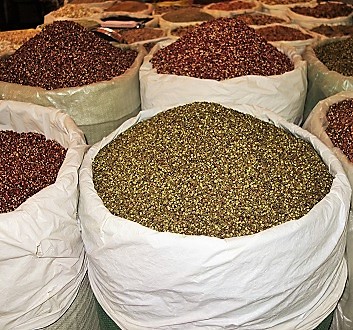
中国, 成都, 成都香料市场
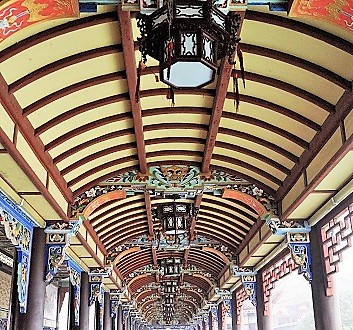
中国, 成都, 都江堰
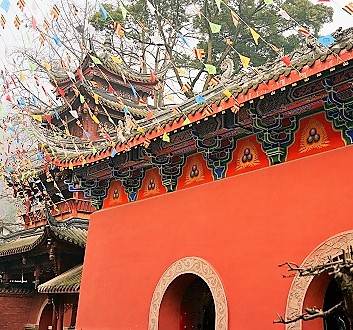
中国, 成都, 青城山, Tai'An
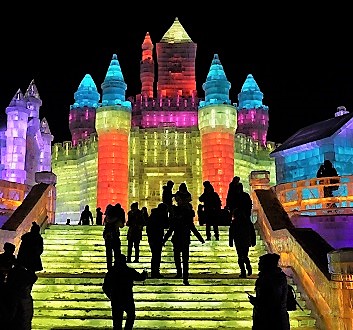
中国, 哈尔滨, 哈尔滨国际冰雪雕塑节
特别的地方
成都 – In Southwest China, the Sichuan Province has a spectacular topography of mountains, rivers and forests. Chengdu, its provincial capital city, is a vibrant center of culture, religious heritage, economic development and superb cuisine. As we explore the city, we discover beautiful parks, ancient alleyways, sacred temples and modern architecture. The Qingyanggong Taoist Temple, located by the Jinjiang River, is one of the oldest Taoist temples that was built during the Zhou Dynasty. In ancient times, the temple was destroyed, then rebuilt and nowadays houses cultural relics, such as: the Hall of Three Purities and the Eight Trigram Pavilion. Adjacent to the Qingyanggong Taoist Temple, the Chengdu Culture Park is a popular gathering place with a teahouse and a venue for the Lantern Festival and traditional Sichuan Opera Performances. A walk toward the Jinjiang River leads us to the Baihuatan Park, a pretty park with waterfalls, the Huiyuan Garden and a famous over 1,000 year old tree. In the heart of Chengdu, the People’s Park houses the oldest teahouse in Chengdu and is a lively place where local residents gather to play mahjong, practice Tai Chi and relax. After enjoying Chinese tea, we proceed to the Jinli Ancient Street, a historic commercial pedestrian street dating back to the rule of the Qin, Han and Three Kingdoms dynasties. The narrow street is decorated with red lanterns and is lined with traditional inns, teahouses, boutiques, restaurants and snack bars. The Kuanxiangzi Alley is another vibrant place with recreated courtyard-style houses, featuring the architectural style developed during the Qing Dynasty. It is a quaint place with boutiques and plenty of souvenir shops. A visit to Chengdu must include an evening of Sichuan opera, a Chinese opera that originated in the Sichuan Province. Sichuan opera is an enchanting performance of music, dance, acrobatics, puppets, shadows and of the famous Face Mask Changing show.
成都大熊猫繁育研究基地 – High in the mountains in Sichuan, Gansu and Shaanxi, China’s western provinces, the natural habitat of giant pandas still remains. The need to preserve the giant pandas’ habitat and the complexity of pandas’ breeding in the wild, resulted in the creation of the Chengdu Research Base. Approximately 10 kilometers north of Chengdu on the Futou Mountain, the Chengdu Research Base encompasses an expansive territory of bamboo forests, rivers, rock enclosures, lakes and green fields, recreating pandas’ natural habitat. Along the beautiful landscape, well-designed exhibits guide the visitors toward giant pandas in different development stages: toddlers, adolescents and adults. The Chengdu Research Base houses giant pandas, red pandas, black swans, beautiful peacocks and varied wild birds. A diverse flora, including fernleaf hedge bamboos and bamboo oriental cherry decorate the pathways in the park. The Chengdu Research Base is dedicated to conserve the endangered giant pandas, increase the population of pandas by improved breeding practices, perform research and educate the visitors from all over the world.
成都文殊佛教寺院,成都香料市场 – The Wenshu Buddhist Monastery is one of the four most important Buddhist Monasteries in China. Previously known as the Xinxiang Temple, it was originally constructed during the Tang Dynasty. The monastery’s gate leads to the Peace Pagoda of the Thousand Buddhas, an eleven storied iron structure decorated with bells on each side. Inside the monastery, there is a vast collection of Tang and Qing Dynasty artifacts, such as Buddha statues created in wood, iron, clay and stone. A short drive from the monastery, the wholesale Chengdu Spice Market displays an abundance of fragrant spices, diverse grains and colorful herbs. As we walk in the spice market, we are overwhelmed by the strong aromas of the Sichuan Peppercorns (花椒 huā jiāo), red chili peppers and other pungent spices. The Sichuan Peppercorns, also known as Sichuan Peppers, are fragrant spices harvested from a tree-shrub of the citrus family that is native to Asia. The Sichuan Peppercorns are an important ingredient in the Sichuan cuisine, adding a flowery aroma and a spicy-numbing flavor.
乐山大佛 – The Leshan Giant Buddha, a UNESCO World Heritage Site, is situated 180 kilometers south of Chengdu near the city of Leshan, at the confluence of three rivers of Min, Qingyi and Dadu. The construction of the 71 meters high Buddha curved in stone began during the reign of the Tang Dynasty in 713 A.D. and took 90 years to complete. The Leshan Giant Buddha is the spiritual project of a Chinese monk named Haitong, who wanted to bring safety and a positive spirit to the vessels navigating through the turbulent waters at the junction of the three rivers. The statue depicts a seated Maitreya Buddha that impresses with its masterly design. The walkways inside the Mount Emei and Leshan Giant Buddha National Park guide us to the ancient symbols of the Wuyou Temple and the Han Dynasty’s Mahao Cave Tombs. The winding pathway along the cliff leads to the giant Buddha situated on the Lingyun Hill. The Leshan Giant Buddha faces the Sacred Buddhist Mount Emei that serves as an important pilgrimage site, the location where Buddhism originally arrived to China.
都江堰, 青城山 – The ancient ecological Dujiangyan Irrigation System was constructed in 256 B.C. with the intention to manage water distribution, prevent floods and improve the agricultural needs of the surrounding farmlands. Situated 56 kilometers from Chengdu, the Dujiangyan Irrigation System was designed by a provincial governor Li Bing to avert flooding caused by Min River. The AnLan Cable Bridge crosses the Min River and offers an unobstructed view of the historic Dujiangyan Irrigation System. In the Dujiangyan Region, the Yulei Mountain creates a picturesque setting for the ancient sites. The Erwang Temple, originally built in memory to an ancient Shu King, was rededicated to Li Bing. The Fulong Temple carries the legend of Li Bing suppressing an evil dragon. In ancient Taoism, people who provided benefit to other people were recognized and honored as Gods. Dating back to the 9th century, a Confucian Temple, destroyed during a 2008 earthquake and since rebuilt, promotes China’s six classical arts: ritual, music, archery, riding, writing and arithmetic. Dujiangyan City, previously known as Guanxian Ancient City, served as an important trading center in ancient times, bringing prosperity to the merchants and to the town. The city’s West Street is the starting point of the Songmao Ancient Path dating back 3,000 years before the ancient Shu people discovered Jade and established their Jade trading center. The pathway along the Min River has the riverside restaurants, shops and a beautiful wooden bridge. Situated 18 kilometers from Dujiangyan City, the forested peaks of the Qingcheng Mountains are important symbols of Taoism. Recognized as a UNESCO World Heritage Site, the Qingcheng Mountains include the Front Mountain hosting ancient Taoist and Buddhist temples and the Back Mountain that offers scenic hiking routes along a forested landscape, streams and wilderness. The Tianshi Cave at the Front Qingcheng Mountain symbolizes the place where Taoist teacher preached during the ancient times. At the foot of the Back Qingcheng Mountain, the old town of Tai An enchants visitors with its rebuilt ancient architecture and Buddhist Temple.
哈尔滨 – China’s three northeastern provinces of Liaoning, Jilin and Heilongjiang were previously known as Manchuria. Harbin, a provincial capital city in the Heilongjiang Province, was founded with the creation of the Chinese Eastern Railway and developed into the metropolitan city it is today. Harbin, situated in the far northeastern part of China, is set along the Songhua River and is a unique fusion of Chinese culture and European architecture and traditions. In the beginning of the 20th century, Harbin experienced a significant influx of Russian population that shaped the city’s culture, architecture and cuisine. The Saint Sophia Church, originally constructed in 1907, reveals its Byzantine architectural style and serves as an exhibition hall summarizing Harbin’s history. A walk from Saint Sophia Church takes us to the Central Street (Zhongyang Dajie), a historic cobblestone street constructed in 1898 and lined with an European style architecture. The Central Street stretches all the way to the Flood Control Memorial Tower and to the Songhua River shoreline, and exhibits mansions designed in the Renaissance and Baroque styles. During the winter season, Harbin is a popular destination to enjoy winter sports, visit a Polar Aquarium and participate in the annual Harbin International Ice and Snow Sculpture Festival. Started in 1987, the Sun Island Park hosts an annual Snow Sculpture Art Expo, featuring a magnificent collection of massive snow statues. The Harbin Ice and Snow Festival was founded in the year 2,000 and attracts millions of visitors every year. During the freezing winter nights, the colorful lights illuminate giant ice sculptures resembling castles, rockets, zodiac symbols and small towns. The annual festival is a huge evening party with its warmly dressed patrons admiring the massive ice sculptures, riding ice slides, watching musical shows and enjoying food snacks and hot drinks. Harbin is a fascinating city with a beautiful European architecture, a vibrant Chinese culture, extraordinary regional cuisine, inviting city parks and picturesque riverside setting.
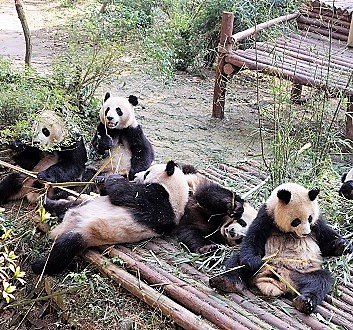
中国, 成都, 成都大熊猫繁育研究基地
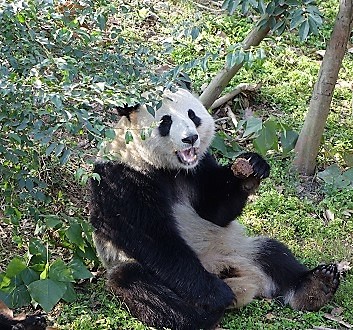
中国, 成都, 成都大熊猫繁育研究基地
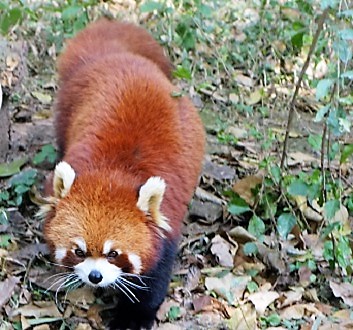
中国, 成都, 成都大熊猫繁育研究基地, 小熊猫
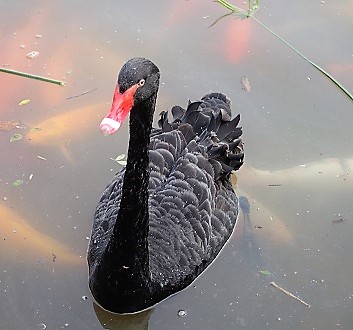
中国, 成都, 成都大熊猫繁育研究基地, 黑天鹅
最好的冒险
成都大熊猫繁育研究基地的野生动物 – The Chengdu Research Base recreates the natural habitat of the endangered giant pandas that live high in the wilderness of the mountains. The Giant Panda, native to Southwest China, is easily recognized by its white and black coloring and distinct black circles around the eyes. The average lifespan of the giant panda is 18 years in the wild and 25 years in captivity. Unlike other bears, the giant panda has a pseudo thumb used to hold bamboo when feeding. The panda’s digestive system enables only the digestion of bamboo’s sugar and protein, resulting in the pandas’ need to eat large quantities of bamboo. At Chengdu Research Center, the Bashania Fargesii (Bamboo species) is the primary food source as it is very nutritious and flavorful. The giant panda does not hibernate in the winter, hence the possibility for us to observe very active pandas during our winter visit. We observe in separate living space teenage pandas, watched by an adult female teacher panda. At another location, a group of female pandas enjoys its daily treat, a delicious protein cake. Our favorite area is the kindergarten of the Giant Panda Cubs where adorable toddlers play and learn to climb. The walkways at the Chengdu Research Base reveal a forested landscape and a peaceful lake with beautiful Black Swans, wild ducks and other colorful birds. While strolling in the bamboo forest we encounter an exotic Red Panda, recognized by its gorgeous orange and brown coat. In the wilderness, the red panda resides at the foothills of the Himalayas, mostly in trees and rock crevasses. The red panda lives on average 10 years in the wild and 14 years in captivity, and enjoys a healthy diet of mostly bamboo but also berries, grass and insects. We spend a blissful time at the Chengdu Research Base admiring these rare and intriguing creatures as they eat, play and relax.
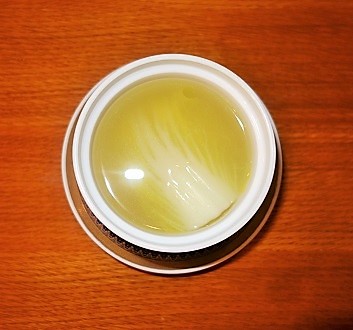
中国, 成都, 四川菜, 汤
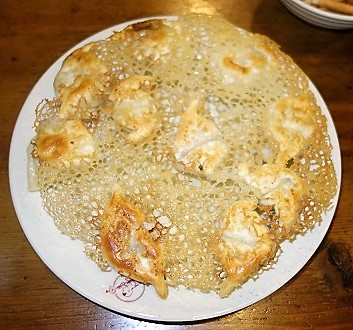
中国, 成都, 四川菜, 炸饺子
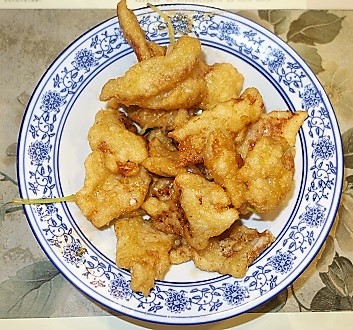
中国, 哈尔滨, 黑龙江美食
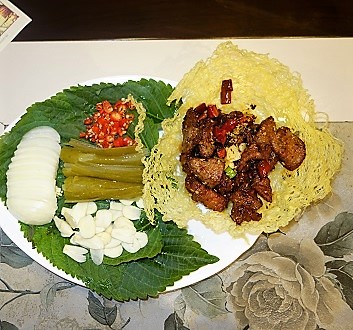
中国, 哈尔滨, 黑龙江美食
所选的菜
四川菜 – In southwestern China, the Sichuan Province captures the visitors’ hearts not only with its beautiful scenery but also with its famous Sichuan cuisine. The connoisseurs of Sichuan cuisine appreciate the lingering flavors of the Sichuan Peppercorns (花椒 huā jiāo) and the Red Chili Peppers. The streets of Chengdu are filled with the scents of the spicy hot pot, a traditional dish originating from the neighboring Chongqing city. The bustling eateries throughout Chengdu are known for their traditional small dishes consisting of tasty dumplings, aromatic soups, spicy noodles, steamed buns and many more delicious dishes. During our trip, we adhere to the recommendations of our guide and sample a variety of classic Sichuan dishes. The clear broth soup with cabbage, seemingly simple but a quite sophisticated dish, delivers a perfect balance of rich flavor and delicate texture. Our selected dumplings are lightly crunchy and simply divine.
黑龙江美食 – The distinct Dōngběi cuisine is influenced by the bordering countries of Russia, Korea and Mongolia. In the city of Harbin in the Heilongjiang Province, we discover a multi-cultural cuisine featuring Russian style smoked sausages, hearty soups, starchy pancakes, Asian sweet and sour dishes, and pickled and fresh vegetables. The renowned dish Guō Bāo Ròu stands out with its sweet and sour flavors, and crispy and soft textures. The pork pieces are coated in starchy dough, flash fried and covered in a sweet and sour sauce. In 1907, the chef Zheng Xingwen created the now famous recipe of Guō Bāo Ròu. His original flagship restaurant on the YouYi Road (across the Bank of Jinzhou, Harbin Branch) continues today to attract patrons. A visit to the Lao Chang Spring Restaurant offers a chance to sample another Dōngběi specialty, thin pancakes served with side dishes of meat, seafood, eggs, vegetables and sweet sauce that are then rolled together.
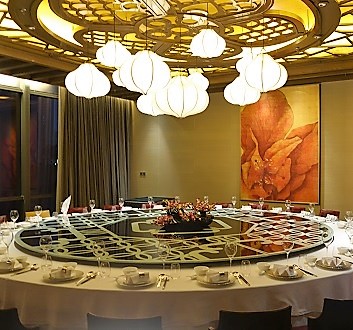
中国, 成都, 成都丽思卡尔顿酒店
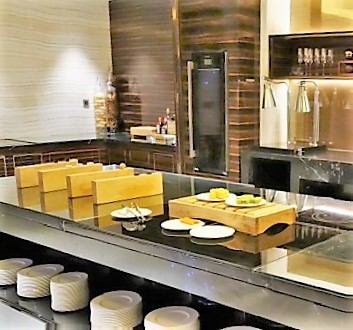
中国, 成都, 成都丽思卡尔顿酒店
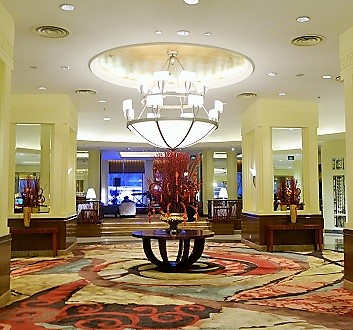
中国, 哈尔滨, 哈尔滨香格里拉大酒店
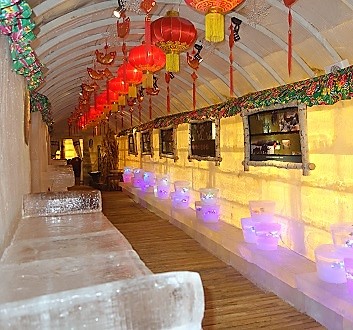
中国, 哈尔滨, 哈尔滨香格里拉大酒店
首选酒店
成都丽思卡尔顿酒店 – Located in the heart of the lively city of Chengdu, the Ritz-Carlton Chengdu offers an escape to tranquility and luxury. The hotel is stylishly decorated, provides excellent guest services and houses wonderful restaurants. Our recommended Club Level Rooms with City View are situated on the higher floors and offer wonderful views of Tianfu Square. An amazing breakfast buffet, served at the Spice Restaurant or at the Club Level, astonishes its guests with a sophisticated array of regional dishes, such as soups, barbequed meats, flavorful congee, fresh breads, colorful salads and much more. The Li Xuan Restaurant, an excellent dinner venue, prepares delicious high-end Sichuan and Cantonese dishes. The Ritz-Carlton Chengdu, situated within walking distance to upmarket malls, shops and parks, is a perfect destination to explore, shop and relax.
哈尔滨香格里拉大酒店 – Situated along the Songhua River, the Shangri-La Hotel Harbin offers comfortable accommodations, especially during Harbin’s cold winter season. Our recommended higher floor Club Level Rooms with Songhua River Views provide extra benefits, such as evening snacks, desserts and drinks served inside the club. The breakfast buffet, served in the Coffee Garden Restaurant, has a diverse selection of Asian and Western dishes. The elegant Shang Palace Restaurant is a perfect venue for dinner and serves superb Cantonese and Heilongjiang cuisines. During the winter season, the guests shall visit the Ice Palace, a restaurant and bar constructed from blocks of ice. The riverside promenade passes near the Shangri-La Hotel Harbin and continues along the frozen river, European architecture, distinct boat houses and spacious city parks.

